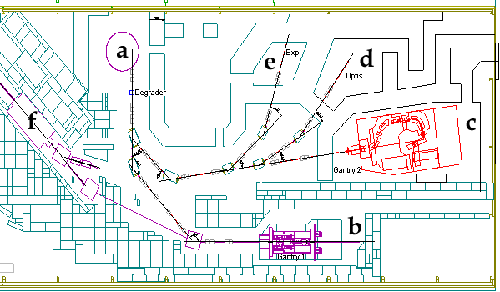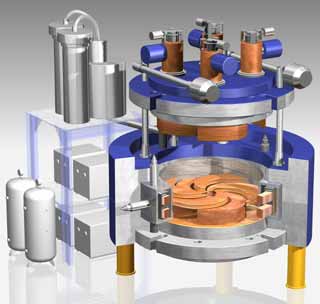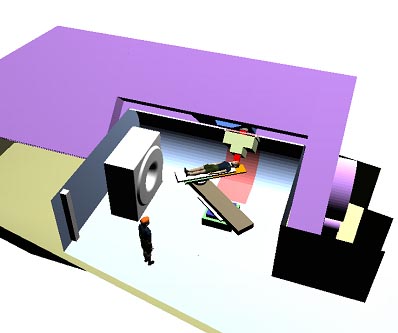| Bulletin 3/02 ----------
President's report
SBMP
Nachruf Prof. Horst
Varian-Preis:
- Reglement
- Preisträger
PROSCAN
Stelleninserate
Tagungskalender
Vorstand SGSMP
(Adressen)
----------
andere Bulletins / d'autres bulletins / altri bolletini /
other bulletins
|
Progress Report
on the PROSCAN
Project of PSI
INTRODUCTION
The number of completed or undergoing installations of new hospital-based facilities for charged particles therapy in Asia and USA is growing quickly and is now reaching a dozen worldwide. Proton therapy will become soon a realistic possibility for cancer treatment at selected large hospitals. All the new commercial systems are based on the passive scattering technique.
The compact gantry for proton therapy at PSI is still the only facility in the world using a beam delivery technique based on the active dynamic scanning of the proton pencil beam. Using this modern approach to radiation therapy the conformal shaping of the dose is achieved just by computer control without need for patient's specific hardware. This approach to proton therapy is attracting more and more interest internationally from industry and hospitals, because this method is now being recognized as the preferred method for providing intensity-modulated therapy with protons (IMPT). In contrast to photon-IMRT, with proton scanning one can control independently proton flux, range, lateral position and direction of each pencil beam, making use of all available degrees of freedom including the depth of penetration of the proton beam into the patient.
The practical feasibility of IMPT delivery was demonstrated recently by a few clinical cases treated at the PSI gantry.
THE PROJECT PROSCAN
Based on the past experience and successes of the present project, PSI decided in 2000 to expand the activities in this field by launching the project
PROSCAN. The overall objective of PROSCAN is to implement and operate at PSI a base technology laboratory for the advancement of proton therapy using proprietary system techniques and applications. This long-term program, which is based on the experience with the PSI compact spot-scanning gantry, aims to optimize the irradiation and treatment techniques and to prepare the compact gantry system for a transfer into a 'marketable product' for hospital applications. The technology transfer of the spot scanning technique to industry is therefore a new major goal of the proton therapy project.
THE FIRST STEP: INSTALLATION OF A DEDICATED SUPERCONDUCTING CYCLOTRON
In the first stage of the project we plan to expand the medical facility at PSI using a dedicated accelerator. The system shall be capable of providing reliable beams of varying energy in several treatment areas during the whole year (without the long shut downs and the problems related to the complexity of the present multi-user-lab system).
Fig. 1 shows the layout of the expanded facility of PSI. The area for a second gantry (gantry 2) will be the one realized first and will be immediately used for the development of advanced beam scanning techniques and for the acceptance tests of the new systems. After successful completion of the commissioning phase, the existing spot-scanning gantry (gantry 1) will be disconnected from the PSI ring cyclotron and will be connected through a new beam transport system to the dedicated 250 MeV compact proton cyclotron. Two additional horizontal beam lines, one for eye treatments (transfer of the
OPTIS program from the injector 1 to this area) and one area dedicated
to experiments (biology, dosimetry and other activities) are also foreseen in the design for a possible realization at a later stage.

Figure 1: Layout of the PROSCAN facility: a = new accelerator; b =
gantry 1; c = new gantry 2; d = new OPTIS area; e = new experimental
area; f = the presently used connection to the 590 MeV ring cyclotron.
Click on image for better resolution.
The planned expansion of the PSI facility was officially started in May 2001 by signing the contract for the delivery of the dedicated accelerator. The 250 MeV super-conducting cyclotron COMET (Compact Medical Therapy Cyclotron) will be delivered by the company
ACCEL Instruments GmbH in Bergisch Gladbach (Germany). The machine is based on an original design of the Michigan State University in the USA and will be realized in close collaboration with PSI accelerator specialists. The first extracted beam is expected at PSI in the second half of 2004.
We can report already on a first success triggered by the PROSCAN initiative, which aims at the promotion of proton therapy on the basis of beam scanning techniques. This is the decision to use a cloned version of the PSI cyclotron for the Rinecker Proton Therapy Center
(PRTC) in Munich. The company ACCEL has been selected for the delivery of the whole technical equipment there, including the four gantries and a horizontal beam line. This new (private) proton therapy center will be the first hospital-based proton facility in Europe (www.rptc.de). The RPTC will be also a novelty worldwide, since it will be based solely on the spot scanning technique, following the strategy chosen by PSI. It can be therefore anticipated that PSI will be strongly involved in the development of the Bavarian center.
Fig. 2 shows an artist view of the novel super-conducting cyclotron. From the user point of view the accelerator shall be optimized for a stable and well-controlled intensity of the beam. A major key feature of the new cyclotron is the dynamic use of the modulation of the intensity at the ion source for improving the speed of the spot scanning technique. To this purpose a deflector plate is mounted in the central region of the machine. For changing the energy of the beam we will use
a fast degrader system, followed by an analyzing beam line section (the energy selector). The degrader, the beam switchyard, the interlock and the control systems are being developed internally at PSI. We plan to vary dynamically the energy along the beam line section to gantry 2 as part of the beam scanning procedure.
|

|
Figure 2: COMET - the medical superconducting cyclotron (courtesy
of ACCEL GmbH). |
THE FUTURE ROLE OF GANTRY 1 WITHIN THE PROSCAN PROJECT
Gantry 1 will continue to be the "working horse" for patient treatments also in the context of
PROSCAN in accordance to the medical program.
Development work performed on gantry 1 will be concentrated on the implementation of IMPT methods into clinical practice, including further developments in treatment planning, dosimetry and quality assurance methods. The synchronization of beam delivery with a given phase of the breathing cycle and the optional use of collimators in addition to scanning are on our wish list as well. The majority of these tasks is related to medicine and medical physics issues and will be performed on gantry 1 in accordance to the original goals of the gantry 1 project.
With the expansion of the facility we expect to be able to treat a larger number of cancer patients (3 to 4 times more than now). With an extended, but limited clinical R&D program, running in parallel to the various technological developments, we intend to contribute, in the international framework together with other centers, to the demonstration of the strengths and the potential of this treatment method. In parallel we aim to support the education of technical and medical specialists in view of the introduction of this therapy method in the hospitals.
DEVELOPMENT OF A NEW GANTRY: GANTRY 2
A major drawback of the spot scanning method is the increased sensitivity to organ motion compared to the scattering foil technique. For solving this problem we plan to develop much faster beam scanning techniques (to be able to apply multiple target repaintings without compromise in the choice of the size of the pencil beam). The new options for improving scanning being considered in the frame of a new gantry 2 are:
a) Double (x,y) magnetic scanning on the gantry,
b) Dynamic energy variation using the degrader, and
c) Use of intensity modulation at the ion source.
For these new developments we need to redesign the system, hardware and software. We are presently in the phase of performing basic conceptual studies for selecting the most optimal geometrical layout for a new compact gantry, with the objectives to optimize the irradiation technique and the precision of treatment, and to upgrade the patient positioning and handling procedures.
Fig. 3 shows a simulated 3d view of the presently preferred concept for a new gantry 2.
Gantry 2 should be realized this time in collaboration with industry.
A possible positive decision to build a new gantry could be taken in the spring of 2003.
 |
Figure 3: A possible layout of the treatment area for
gantry 2 (option with patient table at the isocentre). |
OUTLOOK
The expansion of the PSI proton facility will provide new interesting research opportunities at PSI. It will facilitate the investigation of new medical indications and it will consolidate PSI as a technology base laboratory for advanced proton therapy applications. New exciting technological developments are planned in the context of the realization of a new gantry 2. An active collaboration with industry is a necessary prerequisite for transferring the results to the hospitals. This could be done in form of upgrades for the existing commercial hospital-based systems sold by our commercial partners. In this way PSI could maintain the leadership in this field for several more years.
E. Pedroni and M. Jermann for the PROSCAN team
|
